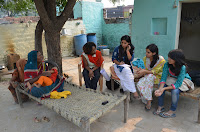Introduction
On 20th and 21st October, seventeen Master’s student from TERI University visited the research sites in Gurgaon. They are enrolled in the M.A. Sustainable Development Practice programme. The objective of the visit was to help them understand how PRAs are used to understand rural life. On 20th October the students visited Sultanpur village, followed by a visit to Jhanjhrola Khera on the next day. It was a diverse group of students, coming not just from different states in India, but also from different countries. A brief note of activities undertaken by students in both the villages is mentioned below.
Sultanpur
The students arrived in Sultanpur at about 10 AM. A walk to the village Sarpanch’s meeting room, called ‘Baithak’ in local parlance, was sufficient to draw villager’s attention towards students. Once everyone was seated in the ‘Baithak’, Dr. Vishal Narain briefed the village head and other villagers about why the students had come to the village. This was followed by a quick round of introduction by TERI students as well as the villagers. After this, the group moved to ‘Dharamshala’ to carry out the PRA activities. All the activities were done with active participation of the village people. One of the first activities was making of the village map.
This turned out to be very interesting for villagers, as they were introduced to such activities for the first time. Many a times, suggestions made by one villager would get contradicted by a fellow villager, especially while delineating specific locations of certain places in the village! But eventually a consensus would be reached and the activity would go on. The combined effort of villagers and students paid off, as the colourful markings on the map made the village look beautiful even on a piece of paper! After this, students formed two to three groups and sat down with group of villagers to carry out other PRA activities like Trend lines, Wealth ranking, Seasonality analysis etc. A map outlining the distribution of supplied water pipelines was also made. This was followed by a transect walk across the village. An integral part of PRAs is sharing the knowledge back with the village communities. This was done in the second half of the day, wherein, the village head and other Panchayat and village members were invited.
All the drawn maps were shown to them and asked for their views and comments. This was the time when some corrections were done to maps based on a mutual consensus among participants. The visit concluded with a final vote of thanks by the students.
Jhanjhrola Khera (JK)
The students arrived in JK at about 9:45 AM. Like Sultanpur, to begin with, a small meeting with villagers and the Sarpanch was held in his house. A quick round of briefing about the activity was followed by a session of mutual introduction. This was followed by some light snacks and tea. After this, a decision was to be made about the location where the activities would be carried out. Dr. Narain aptly suggested it to be the village temple premise. This turned out to be one of the highlights of the PRA activity in JK. Apart from the scenic beauty, the temple premise provided students with a larger space for innovation (as the village map was made on ground) and also for participation by the villagers, as it was a location frequently accessed by them.
Lots of innovation and imagination was employed in making the village map. For example, pebbles were used to highlight sections in the village that are at higher elevation and thus face difficulty in accessing water. Like Sultanpur, this was followed by doing other PRA activities. Students also walked across sections of village. In JK, students were also able to speak to women folk. This was done separately, with a group of 4 to 5 students speaking to a woman in her house. The questions put forth to them were not limited to water, but also about their daily activities, education level of children (especially female children), etc. The women folk targeted were a mix of women from high as well as low castes.
The post lunch session was about sharing with villagers what was learnt from them. This session saw participation of many villagers, including women and kids. It was nice to see some school kids also making their own point about village and other maps. Although women could not be part of the PRA activity in the beginning, women who came to the temple for fetching water, got curious about the ongoing activity and decided to join. They did not hold themselves from putting forth their points!
This was a session where corrections, as and when required, were done. Also, any other important points mentioned by villagers were noted down. The day concluded with heartfelt thanks to the villagers for their participation. Overall, the second and final day of the PRA activity, turned out to be more vibrant, participatory and colourful!











No comments:
Post a Comment